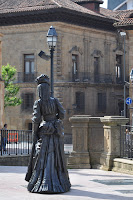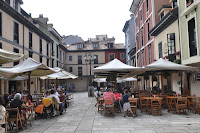(...)
We finally reached Plaza de Porlier with an eighteenth century Palace - Camposagrado located on one of its sides and overlooking the whole square.
To the far end it another imposing statue - "El regreso de Williams B. Arrengsberg made by
Eduardo Urculo, which in realistic terms portrays any incoming visitor
to the city. It had a paper stuck on it, which we realised called the
attention to the problematic of refugees, whose international week was
on.


Upon reaching the next Plaza known as the heart of the historic centre - Plaza de Afonso II, el Casto, where the Cathedral stands, another statue caught our attention - "La Regenta", representing Ana Ozores, the heroine of the great novel by Leopoldo Alas - "Clarin" and which was made by Mauro Alvarez (1997). Said to be the best known "lady" in Oviedo she seemed to be walking away from the Cathedral dressed up in typical attiré of the epoch, whilst firmly holding a mess-book in one of her hands.


Realising I wouldn't have enough time to thoroughly visit the Cathedral I just walked in for some brief moments vowing to come back the following day. Once out I noticed a crowd gathered right in front of San Tirso Church, which stands on the right hand-side of it, in what seemed like a wedding ceremony.
Knowing that most churches are only open during mess, Jonas and I decided to take
the unique opportunity to have a look at its interior by following the wedding guests and walking
into that Roman Catholic Asturian Romanesque Church dedicated to Saint Thyrsus.
Although we only stayed in for a few minutes I still managed to take some photographs, which under normal conditions might not have been authorized.



We then walked towards Calle Cimadevilla from which we could clearly see the Town-hall tower. Built upon an old wall which was formerly the entrance to the city, Juan de Naveda is said to have taken advantage of an existing arch and in 1622 made it into the main access of what is today known as the Town-hall building, which occupies one of the sides of Plaza de la Constitucion..


San Isidro el Real church stood proudly on the opposite side and behind its rather austere façade a whole religious richness unveiled the moment we walked in. I must say I was impressed with its profuse decoration particularly taking into account the fact that it had initially been part of the Jesuit school of San Matias, though it was soon made clear to me that once the Order was expelled in 1767 it underwent several alterations.


We continued walking towards the market and Plaza de Fontan not without having stopped at a local Café to have some tea and relax for a little while prior to having wandered about Plaza de Daoiz y Velarde, which I personally found to be one of the nicest, maybe because of the vibrant yellow and blue one storey high café and the flowers hanging from its verandas contrasting with the sobriety of the 1725 Palacio del Marqués de San Feliz occupying one whole side of the square.









"Vendedoras" by Favile (1996)

(To be continued)




















No comments:
Post a Comment